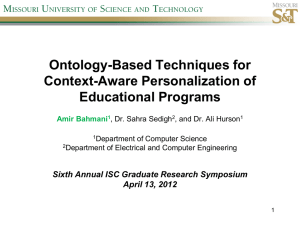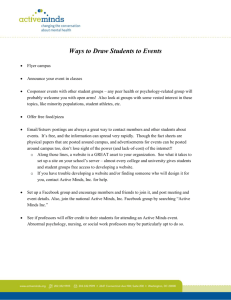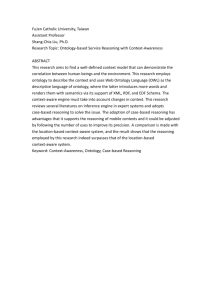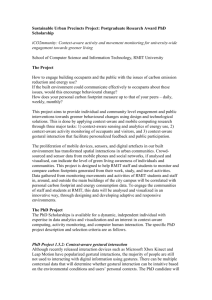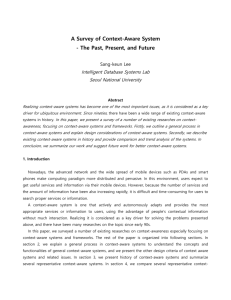ABSTRACT: - Cornell University
advertisement
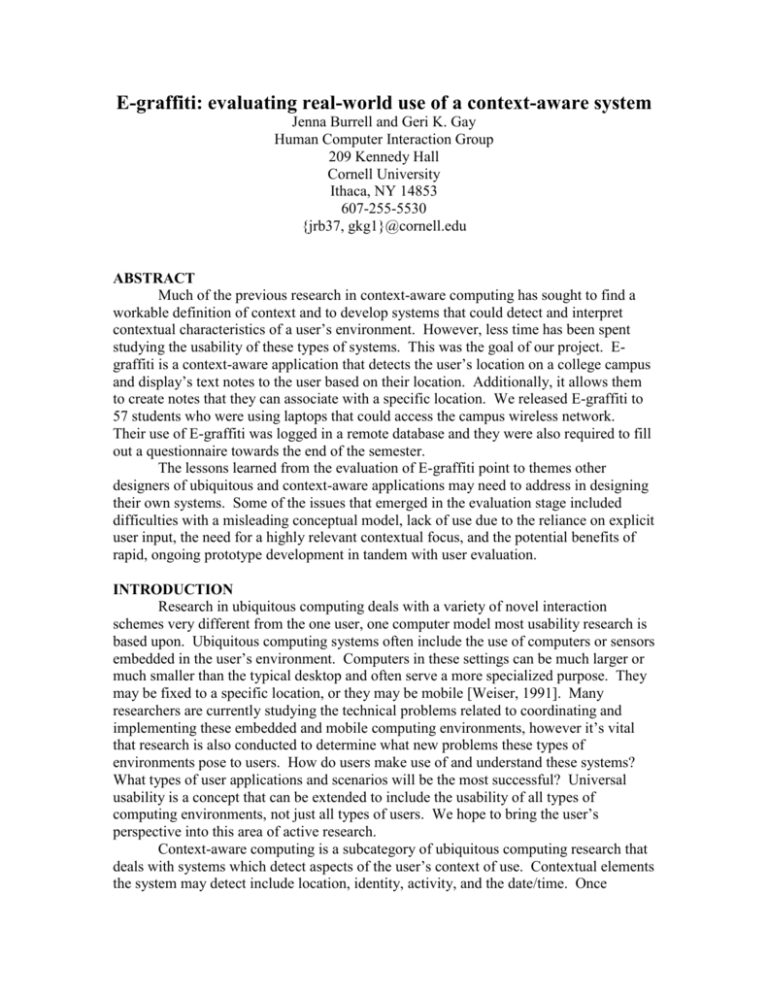
E-graffiti: evaluating real-world use of a context-aware system
Jenna Burrell and Geri K. Gay
Human Computer Interaction Group
209 Kennedy Hall
Cornell University
Ithaca, NY 14853
607-255-5530
{jrb37, gkg1}@cornell.edu
ABSTRACT
Much of the previous research in context-aware computing has sought to find a
workable definition of context and to develop systems that could detect and interpret
contextual characteristics of a user’s environment. However, less time has been spent
studying the usability of these types of systems. This was the goal of our project. Egraffiti is a context-aware application that detects the user’s location on a college campus
and display’s text notes to the user based on their location. Additionally, it allows them
to create notes that they can associate with a specific location. We released E-graffiti to
57 students who were using laptops that could access the campus wireless network.
Their use of E-graffiti was logged in a remote database and they were also required to fill
out a questionnaire towards the end of the semester.
The lessons learned from the evaluation of E-graffiti point to themes other
designers of ubiquitous and context-aware applications may need to address in designing
their own systems. Some of the issues that emerged in the evaluation stage included
difficulties with a misleading conceptual model, lack of use due to the reliance on explicit
user input, the need for a highly relevant contextual focus, and the potential benefits of
rapid, ongoing prototype development in tandem with user evaluation.
INTRODUCTION
Research in ubiquitous computing deals with a variety of novel interaction
schemes very different from the one user, one computer model most usability research is
based upon. Ubiquitous computing systems often include the use of computers or sensors
embedded in the user’s environment. Computers in these settings can be much larger or
much smaller than the typical desktop and often serve a more specialized purpose. They
may be fixed to a specific location, or they may be mobile [Weiser, 1991]. Many
researchers are currently studying the technical problems related to coordinating and
implementing these embedded and mobile computing environments, however it’s vital
that research is also conducted to determine what new problems these types of
environments pose to users. How do users make use of and understand these systems?
What types of user applications and scenarios will be the most successful? Universal
usability is a concept that can be extended to include the usability of all types of
computing environments, not just all types of users. We hope to bring the user’s
perspective into this area of active research.
Context-aware computing is a subcategory of ubiquitous computing research that
deals with systems which detect aspects of the user’s context of use. Contextual elements
the system may detect include location, identity, activity, and the date/time. Once
detected, the system provides services or information relevant to that context. Most of
the existing research in context-aware computing has focused primarily on the problem of
sensing and interpreting context [Salber et al, 1999; Spreitzer and Theimer, 1993; Want
1999], creating a clear definition of context and context-awareness [Dey and Abowd,
1999], and describing the design of various context-aware systems. One of the most well
known context-aware systems is the Xerox Parctab project which provides services such
as call forwarding and interaction tracking in a corporate campus environment [Want et
al, 1995]. Several researchers have created location-aware tour guides which use GPS
coordinates, infrared transceivers, or object detection to determine the user’s location.
This approach was used to design a tour of Atlanta [Long et al, 1996], museum tours
[Rekimoto et al, 1995; Sumi et al, 1998], and a campus guide [Nagao and Katsano,
1998]. The concept of attaching notes to contexts has been proposed to create a tour of
Disneyland [Pascoe 1997]. We have previously created a system that associates web
URLs with locations [Burrell, J., et al, 2000]. Other work has been done in using
context-awareness to assist fieldwork in archaeology [Pascoe, 1998]. This body of
research has made great efforts towards exploring a variety of scenarios of use and
exploring the technical issues involved in implementing a context-aware system.
Purpose of the study
Our study focused less on approaching the technical problems of context
detection and system design, and more on evaluating user’s reception to a system of this
type in real-world use. We wanted to address some usability questions related to contextawareness. In particular we were interested to see what type of information users
associated with their context of use, whether or not they had problems understanding
location-awareness, and if they could find interesting and novel uses for this type of
system. The test system we designed is an application called E-graffiti which is able to
detect the user’s location on the Cornell campus wireless network. This is accomplished
by querying the access points that make up the wireless network to determine which
access point the user is currently closest to. As a result the system is able to determine
what building the user is at. A list of relevant text notes are displayed based on the user’s
location and identity. Users are only able to view the notes associated with their current
location. We made this design decision to force users to confront the location-specific
features of the system. We hoped this would prevent them, as much as possible, from
using E-graffiti like a traditional bulletin board or e-mail system. The application also
allows users to create notes and associate those notes with a specific location on the
wireless network. Users are able to post both public and private notes. Public notes are
visible to anyone who logs onto E-graffiti at that location. Private notes are only visible
to users specifically chosen by the note writer. The information associated with a context
of use in this system is completely defined by the user. The idea of putting the power to
interpret the relevance and meaning of a context in the hands of the users is not typical of
context-aware systems, which usually rely on the system designers to do this work.
Figure 1: Screen Capture of E-graffiti
METHODS
57 undergraduates installed and used E-graffiti over the course of the semester.
Of those users the large majority were members of a communications class who were
given laptops with wireless modems to use for the duration of the semester. These users
were research participants in various studies of wireless network use. They were required
to install E-graffiti as part of their participation in the study. Laptops and wireless
modems were also loaned out to some members of a computer science class and a few
members of this class also installed the program although they were not required to do so.
To track use of the E-graffiti we used two approaches. First we designed the
system to log all usage activity in a database. This was an excellent source of data for
evaluating use of the system. The contents of each note were stored in the database along
with the location it was associated with, the date it was created, and who created it.
When user’s read or deleted notes, the note id and date/time were recorded in the
database. The system also logged how frequently E-graffiti was used at each of the
locations. Since we logged information that was potentially private and sensitive, all
users were required to sign informed consent contracts. They were warned verbally in
advance that the system would log their notes. There was also a warning posted on the
website where E-graffiti was available for download. Our second approach to tracking
use was to hand out a questionnaire to the communications class who made up the
majority of E-graffiti users. The questionnaire asked about their use of the system during
the semester. Questions were open-ended and subjective and tried to identify difficulties
users had with the system that would not be communicated through the usage logs.
In order to make sure users had enough experience with the system to
knowledgeably evaluate it we organized a class assignment on Halloween which
involved using E-graffiti to hold a group discussion. Students in the communications
class were divided into small groups and assigned to various locations around campus
where they had access to the wireless network. Their assignment was to go to the
assigned location and use E-graffiti to answer some questions on the design and usability
of the physical space they were at. It was both a class exercise and a test of E-graffiti.
RESULTS
Initial Use
The initial response to E-graffiti was very positive, as reflected in the notes users
created when they first logged in. The idea of location-specific notes was something that
appealed to users. Some of the comments users made in their notes were, “I’m thrilled to
death that this works,” “It’s a good thing they invented this entirely new useful
technology,” and “This is so great....” However, after introducing the system to the
communications class, use did not extend much beyond initial test messages. To
counteract this, the research team contributed notes to locations all over campus in order
to give users ideas about ways to use the system. This was also done to make sure users
had something to read when they logged on to the system.
Frequency and Location of E-graffiti Use
Users logged into E-graffiti at 16 out of 27 possible locations on the wireless
network. However, 75% of users logged into E-graffiti at only 1 or 2 locations on the
network during the semester. It can probably be assumed that many of the users who
logged into 2 locations logged in at the Kennedy location and at whatever location they
were assigned to for their class assignment. On average the individual user logged in at
1.98 locations (std dev: 0.9). The average user logged into E-graffiti 7.6 times (std dev:
12.6) during the course of the semester.
Number of notes posted
Of the 97 public notes contributed by users of the system 71 were contributed as
part of the class assignment held on Halloween. Users only contributed 26 public notes
of their own free will over the course of the semester. Note posting statistics show a
greater willingness to post private notes. In total, a few more private notes were posted
than public notes, but 99 of those notes were contributed by users of their own free will.
So users seemed to be much more willing to post private notes than public notes.
Table 1: note posting numbers
notes posted for
class assignment
71
public notes
posted
15
private notes
posted
86
total notes
notes posted
voluntarily
26
total notes
99
114
125
211
97
Content of Posted Notes
Relevant information about all posted notes, including the body of the note was
archived in a database for research purposes. This allowed us to read and analyze the
contributions users made to the system. We were particularly interested to see how those
notes related to their location. One surprise was that many of the notes users contributed
seemed to have little relevance at all to the location they were being associated with. For
example, a number of people posted notes advertising websites. Other users simply used
E-graffiti to talk back and forth with a friend in the room like they would with ICQ or
Instant Messenger. Several users posted notes on E-graffiti to ask questions and request
help. Some of these notes were relevant to the location and some were not. A few users
posted notes to see if anyone else was around who was using E-graffiti. Awareness of
the presence of others on the system is a type of context-awareness which students
expressed a desire for through these types of notes. One student who did this was trying
to find someone who had a copy of some readings she needed to do for homework. Other
students made requests for information that were mostly targeted at communications
students. These notes were relevant to the location because they were posted at Kennedy
hall where the communications class was being held and where a large number of
communications students were likely to be present.
Students also posted a variety of different types of notes during the class
assignment held on Halloween. Although students were only required to post public
notes that answered specific assigned questions, they used E-graffiti for other purposes.
For example, one student made a movie recommendation at the building where the
University-run movie theater is located. Another student had some comments to make
about the namesake of the building he was at. Other students posted notes to me about
the usability of the system and problems they were encountering with the UI. Students
also posted private notes to each other to say, “hi” or to comment on something going on
around them. One student posted a note to notify others that there were, “free caramel
apples at Willard Straight right now!” Many students used E-graffiti to coordinate the
activity, “...at the tables outside CTB...and freezing,” and “where are you?” were some of
the notes they posted to make sure everyone was at the right location and logged onto Egraffiti.
Table 2: Examples of Note Types
synchronous
communication
related to location on-topic discussion
of lecture
material:
“system reliability
is overrated…”
not related to
location
chatting and
whispering in
class:
“hi Janet”
“hi, what’s up?”
asynchronous
communication
bulletin board ads:
“Prof. Brown is
presenting a lecture
tomorrow at noon
here at Upson.”
system
functionality
awareness of user
presence:
“is anyone in Uris
right now studying?
I didn’t pick up the
readings in class on
Thursday…”
bulletin board ads:
“Check out
wizzle.com the
Ultimate Online
Classified Solution”
user interface and
general
functionality
suggestions:
“I think it would be
nice if we could
have different
windows open at
the same time.”
Problems Understanding Location-Awareness
Few users have any experience with computer applications that have the ability to
detect the users location and act on this knowledge. GPS systems come to mind, but they
were not in widespread use among the users in this study. Since this functionality is so
novel to users we were particularly interested to see whether location-awareness was a
difficult concept to grasp. We wondered what aspects of our system design might affect
user’s ability to understand the location-awareness functionality. Contents of the notes
themselves also indicated an understanding, or misunderstanding of location-awareness.
For the most part users seemed to understand that E-graffiti could determine their
location. We attempted to facilitate this when we designed the system by visibly
displaying the user’s location on the user interface once it has been detected. For
example, if a user was using E-graffiti at Kennedy Hall, both an illustration of the
building, and the words, “Kennedy Hall” would appear to the user. However, a few
people still seemed to misunderstand that notes they posted at a certain location could
only be viewed at that location. For example, one user posted a note that asked, “How
did everyone’s midterm go?” shortly after the communications class had their midterm.
However she posted this note at Upson hall. This didn’t make sense because Upson is
where the computer science department is and few students in the communications course
would ever be at that location. Another problem users had with understanding the
location-awareness features of the system was due to an oversight in the design of Egraffiti. Users were able to post a note to any location on the wireless network despite
their current location. However, once the note was posted, there was no indication of
where the note originated from. This points to a special usability need of context-aware
systems that involve communication or the awareness of other users. These types of
systems should visibly indicate the context of other users if the current user might have
any reason to interact with them. In this case we should have added some sort of text or
illustration to each note indicating where the user was on campus when they created the
note. This was an important part of the context of the note.
E-graffiti’s Conceptual Model
Users adapted E-graffiti to fit their own preferred communication patterns which
didn’t necessarily match the communication patterns we had in mind when designing the
system. The intended purpose of E-graffiti was to allow users to, in essence,
communicate through locations, to use a location as a sort of proxy for information
sharing. The appropriate model of use for the system would have been an annotation
system where users could communicate asynchronously by annotating a location with
relevant information. However, users saw it differently. They used E-graffiti as a type of
networked instant messaging or e-mail system. In fact, synchronous conversations
between friends using E-graffiti was a tactic many students used to “whisper” in class.
There were a few especially interesting examples of this. Two students posted private
notes back and forth so they could talk about another student in class whom they dislike.
Another pair of students communicated in this way to evaluate the reaction of other group
members over a proposed research topic for a project. During a lecture in a computer
science class two students used the system to try to spark a discussion relevant to what
the professor was talking about. One student in the class asked in a public note, “Have
you ever heard of ‘gopher’ protocol before? What is it?” Another student commented
several weeks later during a different lecture, “Who cares about system reliability? If the
thing doesn’t work it keeps the tech support industry profitable....”
There were several problems users encountered with using E-graffiti as a chatting
tool. The main problem with using the system in this way is that it did not take
advantage of the context-aware functionality of the system, which is what makes Egraffiti unique. There are a variety of chatting tools available that are much better
designed for that purpose than E-graffiti. In part because users tried to synchronously
chat they found the context-aware capabilities limiting. They became frustrated with
their ability to chat only with users who were at the same location as themselves and who
were registered with the E-graffiti system. E-mail, the argued, would allow them to send
notes to any of their friends no matter where they were. In the E-graffiti questionnaire
one user commented, “I can reach more people through e-mail,” another commented,
“there was no unique feature. Why not use e-mail?” and a third user commented “only
accessible to notes in one place – I view the Internet as being all places – didn’t like
limitation.” They were also frustrated by the fact that notes did not pop up dynamically
when they were created like they would in an instant messaging client.
Users gravitated towards using E-graffiti as a chatting tool and this behavior can
be explained in two ways. The first explanation relates to the conceptual model we had
in mind in designing E-graffiti. Norman distinguishes between the conceptual model of a
system, the mental model of a system, and the system itself [Norman, 1983]. The
conceptual model is the way we the designers think of the system as we are designing it.
The mental model is how the users think of the system. In the case of E-graffiti, to make
the interface as intuitive and easy to use as possible we tried to tap into users mental
model of e-mail. Notes had to, from, subject and body fields and each note had a small
envelope icon next to it to indicate whether it was new or old. In actual use these small
features were more overpowering than we expected and many students came to see Egraffiti as another form of e-mail. As a result they saw the location tracking feature as
irrelevant or as a limitation because it prevented them from getting e-mail to it’s
appropriate recipient. One user commented that she did not use E-graffiti much because,
“...notes left for me at one location can’t be picked up from another.” It’s not surprising
that users latched on to the e-mail model and ignored the location-aware aspects of the
system. Their previous experience with communication technologies dictates a model
where an item of information goes from one individual (the sender) to another (the
recipient). Location-awareness is not a standard capability for the computers these users
have encountered so a conceptual model must be chosen carefully when designing
context-aware systems so that it does not limit the users concept of how to use the
system. In the case of E-graffiti, a better method might have been to use a map of
campus to organize the notes and to support attaching notes to locations on the map
interface. The map would emphasize the location-aware aspect of the system and a
conceptual model suggesting annotation, rather than e-mail. We also could have
removed the private note functionality entirely. This way there would be no suggestion
of a message from someone to someone and users would not so easily rely on existing
communication technology models.
The second explanation for users adapting E-graffiti into a type of chatting tool
relates to social influence. Once a few users started using E-graffiti as a direct
communication tool, others adopted that behavior. It has been shown that behavior and
attitudes towards technology can also be influenced socially, by observing what others do
and say [Fulk, 1993]. Initially, members of the communications class were at a loss as to
how to use E-graffiti. Only a few members of the class had to step forward to
demonstrate a way of using E-graffiti and others quickly adopted this way of use. So, the
use of E-graffiti as a chatting tool spread through social influence. We attempted to
influence use socially in a similar way to encourage users to take advantage of the
location-aware functionality. We did this by posting our own notes that did not follow
the chatting model users had already demonstrated. For example, we posted notes that
announced events happening at that location, or questions about the facilities. There was
some response to this approach with a few users responding to our questions, or posting
similar notes.
Motivating Users to Contribute
E-graffiti relied on users to post notes for it to be a successful application. The
reliance on explicit user input was useful on one level because it allowed users to actively
participate in the definition of the system. This gave us, as researchers, a great deal of
information on how users were receiving the system and what ideas they had about
context-aware computing. However, motivating users to contribute was a real challenge.
In the questionnaire users commented 23 times about the lack of use by others as a reason
for not using the system. One user pinpointed the problem when she said that E-graffiti
“didn’t seem like it was very useful since not popular.” The concept of critical mass
describes the phenomenon where the usefulness of a system decreases as the number of
users decreases [Rogers, 1986]. For E-graffiti this means that the fewer people using the
system the fewer notes people will contribute and the less value other people will get out
of the system by reading those notes. Grudin has pointed out that many failed
communication technologies require that some people do additional work (such as
posting notes) while other people reap the rewards (reading informative notes) [Grudin,
1998]. In some ways E-graffiti suffered from this problem. People knowledgeable about
the campus might contribute notes and gain little from notes others contribute, while
those who are new to the campus cannot contribute much information, but can gain much
from the notes others post.
Most context-aware systems to date have relied largely on implicit user input
(such as the presence of someone at a location) to provide appropriate tools or
information to the user. This is certainly a good strategy especially in a research
environment when the time and number of users available is often not adequate to build
enough of a user base for the system to be self-sustaining. Systems relying on implicit
user input require little effort on the part of users, but merely their presence on the system
is enough to provide value to other users. Based on our experience with E-graffiti we
would recommend that designers incorporate implicit user input into their systems in
such a way that it is useful to the user without being dependent on explicit contributions.
For example, our system might have benefited if it displayed a dynamically updating map
which displayed current wireless network traffic along with the on campus locations of a
list of buddies. Users would contribute implicitly simply by being at a location.
Need for Highly Relevant Contextual Focus
At this point in time context-aware applications are not a part of daily life for the
general population and so users may have only vague ideas about how or why a particular
context-aware system would be useful. This was clearly the experience of users of Egraffiti. They reported in large number that they didn’t really think about information in
terms of location, didn’t know what notes to write, and didn’t really have anything to
share with others at a location. E-graffiti was too open-ended; it provided too many
options. Users could post notes of any kind, but they did not have the time or energy to
think extensively about location and the information that might be relevant to their
current context. Users needed more directions and suggestions about unique ways to use
the system. To resolve this issue context-aware applications might be designed around a
highly relevant contextual focus, for example paintings in an art museum, or buildings on
a campus tour, something that certain user groups at that location would have a vested
interest in. In the results of the questionnaire many users commented that E-graffiti
would be useful if applied purely to the realm of classroom activities such as lectures,
discussions, and grades. This would also have been a more relevant contextual focus.
Need for Rapid Iterative Prototype Development
From the initial stages of designing E-graffiti we planned an iterative design
process where we would use our evaluation of E-graffiti to design a different, better,
more informed system. However, we did not anticipate the need for more short-term
iterative design, from simple bug fixes to small UI adjustments. Many of the surprises
and unexpected uses of E-graffiti described in previous sections demonstrated this need
for a rapidly evolving design process. Getting users to download and successfully install
the application involved two class sessions with lots of hands on assistance. After E-
graffiti was installed on everyone’s laptop, it was not possible for us to make changes to
the program and try to persuade users to reinstall it again and again. As Abowd points
out, “It is very hard to predict what a compelling application might be, particularly since
a novel application is likely to coevolve with its user population in unpredictable ways,”
[Abowd, 1999]. As soon as we released E-graffiti ideas and problems began to emerge
that we had not anticipated and users made use of the system in ways we did not expect.
Most notably, as mentioned before, users adapted E-graffiti into a sort of instant
messaging tool. The ability to change and adapt E-graffiti immediately would have been
an excellent way to address these issues and would have allowed us to address new
research questions more directly. We could have tried adding an interactive campus map
to the system to see if that would affect the kinds of notes users posted and how they
communicated with other users. In future systems we plan to include a feature that will
upload the most recent version of the application to the users computer automatically.
This will make the iterative design process more immediate, and allow us to make small
adjustments and observe the results.
FUTURE PLANS
Our goal for future systems is to incorporate the major issues brought up in the
evaluation of this system into new systems. To address these issues we have two projects
currently underway. One project is a dynamically updating campus map which allows
users to see where other users are on campus. The system will be designed to allow
spontaneous, informal group discussions with others who are close by. E-graffiti is a
social system which allows users to communicate with one another via note posting.
However, we did not design the system to support any dynamic user-awareness
functionality. This capability was something users requested and it adds to the contextawareness of the system. Detecting the presence of others is a useful piece of contextual
information. We believe this system will be an improvement from E-graffiti because it’s
an answer to user requests for user-awareness functionality and it does not require
explicit user input to be useful. In fact, if no one is using the system at all it will still
provide the user with general wireless network traffic information that is always
available. We also hope to study issues of privacy with this system. A second project is
a location-aware museum tour for handhelds. This system will allow us to see if
understanding and use of context-aware systems improves in an environment where the
context is highly relevant to the user. The museum tour will also allow us to address
some new issues, like designing for novice users. Ideally museum patrons can come to
the museum, pick up our system and immediately be able to use it without training. We
also hope to explore a diversity of users by reaching out to people outside of the campus
environment. Museum patrons are a start to this goal. Context-aware computing is a
concept that may be more useful to some user populations than others. For example,
people with impaired vision or hearing may benefit more from the added environmental
awareness a system like E-graffiti could provide. These new systems and new user
populations will help us to further explore the usability issues associated with ubiquitous
and context-aware systems.
Abowd, G.D. Classroom 2000: An experiment with the instrumentation of a living
educational environment. IBM Systems Journal, 38(4). (October 1999), 508-530.
Burrell, J. et al. Designing for Context: Usability in a Ubiquitous Environment, in
Proceedings of CUU 2000. (Arlington VA, November 2000), ACM Press, 80-84.
Dey, A.K., and Abowd, G.D. Towards a Better Understanding of Context and Context
Awareness, in Proceedings of the CHI 2000 Workshop on The What, Who, Where, and
How of Context-Awareness. (The Hague Netherlands, April 2000).
Fulk, J. Social construction of communication technology. Academy of Management
Journal, 36(5). 921-950.
Grudin, J. Why CSCW applications fail: problems in the design and evaluation of
organizational interfaces, in Proceedings of the Conference on Computer-Supported
Cooperative Work. (Portland OR, September 1998), ACM Press, 65-84.
Long, S. et al. Rapid Prototyping of Mobile Context-Aware Applications: The
Cyberguide Case Study, in Proceedings of the 2nd ACM International Conference on
Mobile Computing and Networking. (White Plains NY, November 1996), ACM Press,
97-107.
Nagao, K., and Katsano, Y. Agent Augmented Community: Human-to-Human and
Human-to-Environment Interactions Enhanced by Situation-Aware Personalized Mobile
Agents, Community Computing and Support Systems. Springer, 1998, 342-358.
Norman, D.A. Some observations on mental models. In D. Genter & A.L. Stevens
(Eds.), Mental Models. Lawrence Erlbaum, Hillsdale NJ, 1983, 7-14.
Pascoe, J. The stick-e note architecture: extending the interface beyond the user, in
Proceedings of the 1997 International Conference on Intelligent User Interfaces, (1997),
ACM Press, 261-264
Pascoe, J. Enhanced Reality Fieldwork: the Context-aware Archaeological Assistant. In
V. Gaffney, M. van Leusan and S. Exxno (Eds.), Computer Applications in Archaeology
1997. Tempus Reparatum, Oxford, 1998.
Rekimoto, J., and Nagao, K. The World through the Computer: Computer Augmented
Interaction with Real World Environments, in Proceedings of UIST ’95, (November
1995), ACM Press, 29-38.
Rogers, E. Communication Technology: The new media society. Free Press, New York,
1986.
Salber, D. et al. The Context Toolkit: Aiding the Development of Context-Enabled
Applications, in Proceedings of CHI ’99 (Pittsburgh PA, May 1999), ACM Press, 431441.
Spreitzer, M., and Theimer, M. Providing Location Information in a Ubiquitous
Computing Environment, in Proceedings of the Fourteenth ACM Symposium on
Operating System Principles. (Asheville NC, December 1993). ACM Press. 270-283
Sumi et al. C-MAP: Building a Context-Aware Mobile Assistant for Exhibition Tours.
Community Computing and Support Systems. Springer-Verlag, Berlin, (1998), 137-154.
Want, K., et al. The PARCTAB Ubiquitous Computing Experiment. Xerox Parc technical
report, 1995.
Want, K., et al. Bridging physical and virtual worlds with electronic tags, in Proceedings
of CHI ’99 (Pittsburgh PA, May 1999), ACM Press, 370-377.
Weiser, M., The Computer for the 21st Century. Scientific American, 265(3). 94-104.

